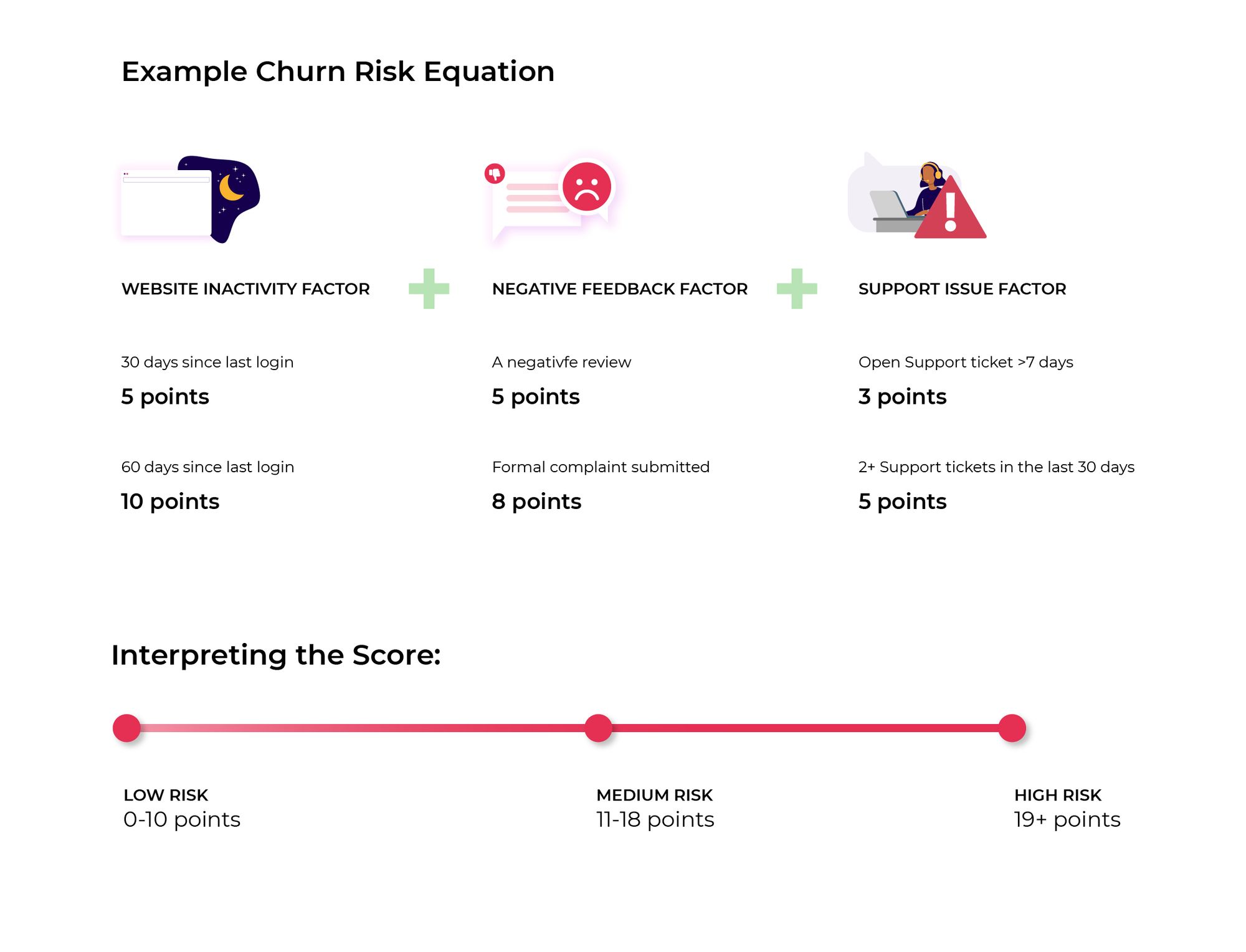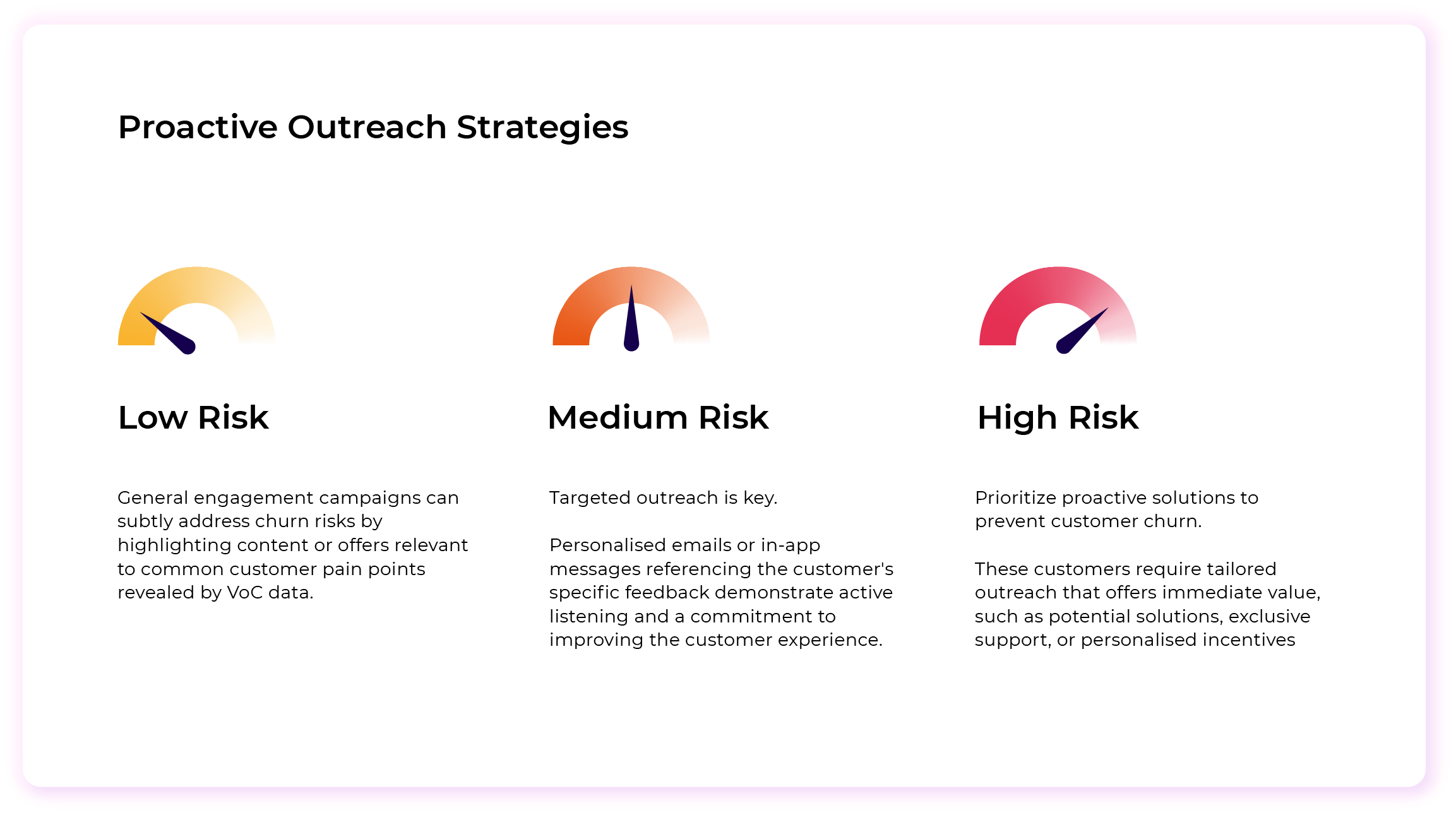

A focus on customer acquisition often overshadows the vital task of retention.
A shocking 66% of consumers end relationships with companies due to poor customer service. This highlights a disconnect: Customers crave positive experiences, yet businesses sometimes must listen proactively.
The consequence? Churn – lost revenue, tarnished reputation, and wasted effort. The good news is that churn isn't inevitable. Voice of the Customer (VoC) empowers you to shift from reactive to proactive, identifying those at risk of leaving before it's too late.
Understanding the "why" behind potential churn can improve the overall customer experience (CX) and safeguard your bottom line.
Customer churn refers to the percentage of customers who stop doing business with a company within a given period. It's a critical metric for businesses of all sizes, directly impacting revenue, reputation, and overall growth. There are two main types of churn:
Customer churn is often a direct consequence of negative customer experiences. Think of churn as a final symptom indicating an underlying problem. Here's how poor experiences often fuel customer churn:
Voice of the Customer (VoC) data is your most powerful tool for uncovering the reasons behind customer churn. You gain insights beyond churn numbers by systematically collecting and analyzing customer feedback from various sources (surveys, reviews, social media, website interactions, and support tickets).
Voice of the Customer data pinpoints recurring frustrations, unresolved pain points, and unmet expectations that ultimately fuel customer churn. Analyzing this data helps you identify the specific areas where customer experience is faltering, empowering you to take targeted action to prevent customers from leaving in the future.
Here's why reducing customer churn is a non-negotiable for customer-focused businesses.
Without a churn risk model, your approach to customer retention remains reactive. You might notice a spike in churn and scramble to investigate the cause, but by then, it's often too late to retain those customers. A churn risk model empowers you to shift from reactive to proactive by identifying at-risk customers early, allowing you to intervene before they leave.
Not all customers leave for the same reasons, and generic retention strategies are rarely effective. A churn risk model, informed by your specific data, allows you to personalize interventions.
For example, you might focus on:
Attempting to improve every customer's experience can be expensive and time-consuming. A churn risk model guides you toward the right actions with the most significant impact. You can focus your resources on those customers most likely to leave, preventing lost revenue and preserving your investment in acquiring those customers.
Intuition can be misleading when it comes to customer churn. A churn risk model empowers you to make informed, data-driven decisions. By analyzing the data and identifying the factors that contribute to customer churn, you can:
Companies that actively manage their churn risk demonstrate a commitment to customer experience. This focus on customer-centricity builds trust and loyalty, making you stand out in a competitive marketplace. Investing in a churn risk model shows you're dedicated to truly understanding your customers and continuously improving their experiences.
Voice of the Customer (VoC) data is a treasure trove of insights that can fuel a robust churn risk model. By carefully analyzing customer feedback and behavioral patterns, you gain the power to anticipate potential churn and take proactive measures to improve customer retention.
Here's how to translate Voice of the Customer data into actionable churn reduction.
Start by examining various sources of voice of the customer data to pinpoint the signals that often indicate that a customer is at risk of leaving. Consider these key indicators:
Analyzing your historical churn data is essential for building your predictive model. Examine the behavioral patterns and feedback trends present in past churned customers. This analysis allows you to assign weights to specific data points based on how strongly they correlate with churn.
Develop a churn risk scoring system that incorporates these findings. It will allow you to identify customers at varying levels of risk proactively. Predictive modelling tools or statistical analysis techniques can further refine your model and improve its accuracy, but remember—the insights gained from VoC data provide the foundation.

Churn Risk Score = (Website Inactivity Factor) + (Negative Feedback Factor) + (Support Issue Factor)
Where:
Interpreting the Score:
Important Notes:
Not all at-risk customers are at the same stage of disengagement. Segmenting your customer base by risk level allows you to tailor interventions and resources effectively. Here's a basic example:
Harnessing the power of the Voice of the Customer (VoC) can proactively prevent customer churn and elevate the overall customer experience. Segmenting customers by risk level lets you personalize your interventions for maximum impact.

Voice of the Customer (VoC) data illuminates the "why" behind customer churn risk. Use these insights to fuel positive change and improve the overall customer experience:
Sometimes, a well-timed offer or gesture can be the deciding factor for a customer considering leaving. Loyalty programs or targeted incentives can help retain higher-risk customers and demonstrate your commitment to providing a positive customer experience.
Here are some strategies informed by Voice of the Customer (VoC) insights:
Even with proactive churn prevention efforts, there are times when customers leave. However, VoC data can be a powerful tool for winning them back. By understanding the reasons behind their departure, you can create targeted and personalized win-back campaigns that resonate with these lapsed customers.
Start by reviewing the feedback provided by churned customers. This valuable data can be found in:
Voice of the Customer data helps you move beyond generic "we miss you" win-back campaigns. By tailoring your offers and messaging to why customers left, you significantly increase your chances of re-engaging them.
Generic win-back campaigns often fall flat. Voice of the Customer (VoC) data allows you to ditch the one-size-fits-all approach for targeted outreach. Demonstrate that you've listened to churned customers by referencing their past feedback in your win-back efforts.
Directly address their concerns, showcasing that you're committed to improving their experience. Additionally, segment your audience based on common reasons for leaving. This will ensure your win-back offers are relevant and resonate with specific groups of churned customers.
Implementing a VoC-driven churn reduction strategy is an investment, and tracking the results is crucial. By defining clear success metrics and showcasing the return on investment (ROI), you can demonstrate the value your VoC program brings to the business.
While overall churn rate is important, go deeper to understand the true impact of your VoC initiatives. Track the following:
Present a compelling business case for your VoC program by highlighting the financial and ROI impact. It could include:
Truly leveraging VoC for churn reduction goes beyond tools and analysis. It requires embedding customer-centric thinking into the fabric of your organization. Here's how:
A customer-centric culture only happens after a period of time. By consistently sharing VoC insights, celebrating wins, and empowering employees at all levels, you create an environment where preventing churn and enhancing customer experience becomes a shared mission across the company.
Churn quietly erodes your bottom line and damages your hard-earned reputation. Every lost customer represents missed recurring revenue and the potential for negative word-of-mouth that can deter future customers. The financial and reputational costs are simply too high to ignore.
Voice of the Customer (VoC) transforms your approach. It's the key to shifting from reactive customer service to proactive churn prevention. By systematically analyzing customer feedback, you gain insights into the root causes of dissatisfaction and take action before customers head for the exit.
Are you ready to stop guessing and truly understand the "why" behind churn? Thematic is here to help. Unlock the actionable insights hidden within your customer feedback and proactively improve the customer experience. Begin your journey with a guided trial of Thematic and discover the power of the Voice of the Customer in action.
Join the newsletter to receive the latest updates in your inbox.